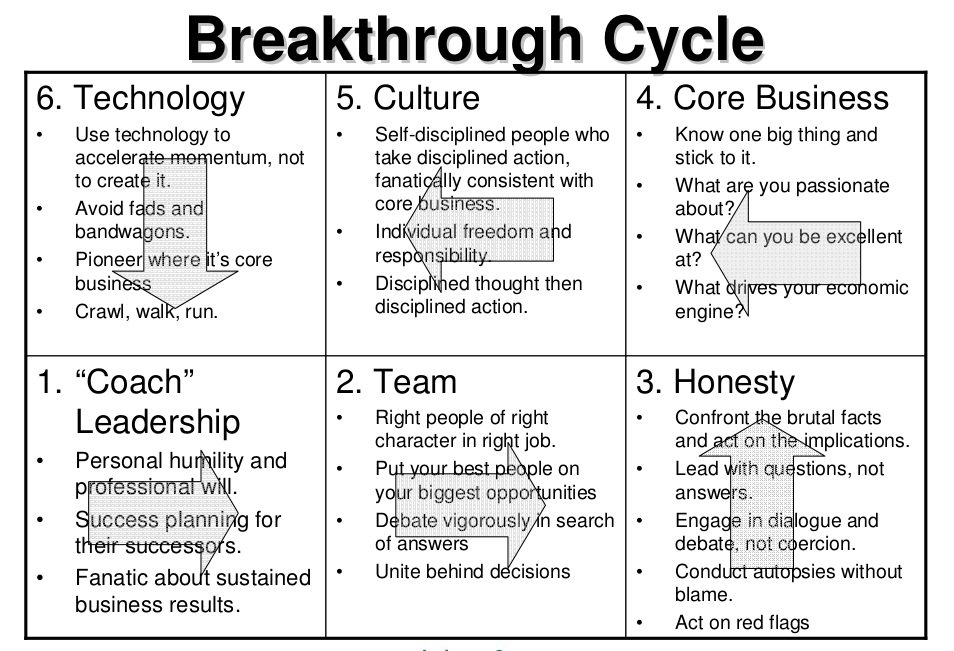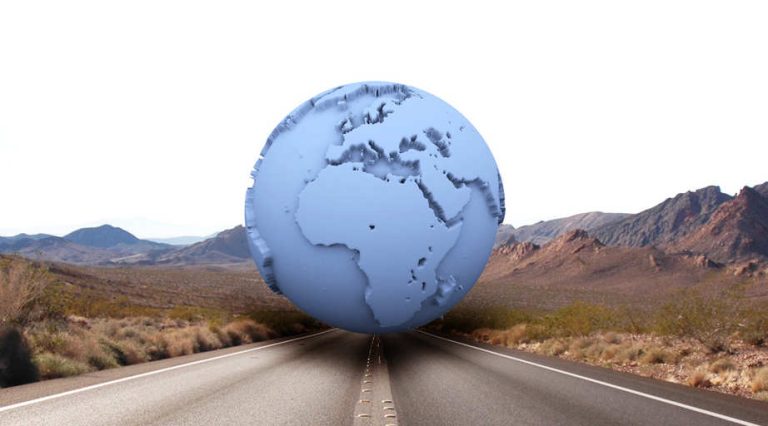Winning the sustainability game with Good to Great
In 2001, Jim Collins published his research into the factors that turned good businesses into great businesses, performing well above their industry average over long periods of time. The title of the book is “Good to Great. Why Some Companies Make the Leap and Others Don’t”.
Collins described a cyclic process of 6 steps that – pursued persistently – significantly increase and sustain outstanding business performance. He called this cycle of steps “the Flywheel”. The 6 steps are:
- Develop ” Level 5″ leadership. The process starts with leaders who are smart coaches, not charismatic heroes.
- Focus first on WHO, then what. Build the right team and work with them in deciding what to do.
- Practice brutal honesty. Acknowledge what’s going on (and have faith you can deal with it). Create permission for the truth to be heard and dealt with.
- Find your hedgehog. Deeply understand the core drivers of the business you’re in – the place your passion, excellence and customer value meet.
- Develop a culture of discipline where everybody understands what the rules are for “our game” and how to play it well.
- Use relevant technology to accelerate business performance based on sound strategy.
This process is highly relevant to successful business sustainability programs. It will help you take a strategic approach and avoid costly mistakes. There are good lessons for business sustainability programs to be learned from Collins’ work. Here are some of the key lessons we see.
Practice level 5 leadership
Develop leaders who are visionary and ambitious for the organization (and the world).
- Be visionary – prepared to climb Mount Sustainability and look beyond compliance, for regenerative opportunities. Set the goal of thriving in the face of environmental challenges.
- If you don’t think you’ve got Level 5 leadership, invest in it. The rest of the Flywheel grinds to a halt without this first crucial element. And don’t limit this to the board room – drive it outwards.
Get the right people on the bus – decide who before what
It doesn’t matter how good your strategy is if you don’t have great people to execute it. Get the right people on your team before you decide what your strategy is.
- Consider the relevant skill & knowledge bases that will be useful, such as biomimicry and life cycle analysis.
- More importantly, audit for critical personal qualities such as systems thinking and innovation adoption. Search for win/win/win thinkers.
- Put your best people on your biggest issues – and sustainability is a big issue. It’s going to be a core business strategy, so put someone strategic on it.
Confront the brutal facts
Retain absolute faith that you can and will prevail in the end regardless of the difficulties AND at the same time confront the most brutal facts of your current reality:
- Accept that humans are impacting the eco-system, and it’s likely to be catastrophic if changes aren’t made. Plan to be a winning change-maker.
- Practice absolute honesty on your ecological footprint. See the whole system, not just your internal view. Go hunting for your unique opportunities.
- Your impact runs all the way up and down your supply chain. If you don’t know what Scope 1, Scope 2 and Scope 3 are find out!
Know your hedgehog
Where does you expertise, passion and value meet? What can you be the best in the world at? What are you passionate about? What drives your economic engine?
- Fully understand the nature of the valuable service behind your product. Design it to be delivered in ways that regenerate the eco-system, build community AND increase prosperity.
Build a culture of discipline
Design for freedom and creativity within a disciplined, highly developed framework. Develop disciplined people who engage in disciplined thought and take disciplined action. Define the rules and responsibilities well, then let people get on with it. This doesn’t mean build a bureaucracy – it means develop some discipline.
- Hire environmental experts to teach, not consult. Impregnate the business with environmental literacy and let the workers do the work.
- Build the framework and the culture and the results will happen. (If you don’t have them, here’s a good motivation to start building them.)
- Enhance your existing disciplines before you build new ones. (For example, add GHG emissions to your existing Zero Waste system rather build a new system.)
Use strategic technology accelerators
Thoughtless reliance on technology is a liability – grasped as an easy solution, without deep understanding of its link to strategy, technology accelerates declines, not success. Technology of itself doesn’t create great results – well chosen, well-implemented technology aligned with the core business strategy delivers:
- Small, smart, local, relevant technology solutions can deliver great win/win/win results.
- Don’t invest in cool, green technologies without evaluating them against your hedgehog. Find a relevant evaluation tool and use it rigorously.
Interface and Good to Great
Global carpet tile manufacturer Interface, named the ‘Most Sustainable Large Corporate’ at the 2012 International Green Awards is a great case in point. Every element in the Good to Great “Flywheel” is evident in the story of their success, whether it was conscious practice or not. Read Ray Anderson’s “Business Lessons from a Radical Industrialist” alongside “Good to Great” and you’ll see what I mean.
Where to start?
The answer for this one comes from Jim Collins – it starts with building “Level 5” leadership. Lasting business success starts with highly developed leadership capability. The core skills of successful leadership are learnable conversational skills. Make sure your management team has them – if they don’t, start building them.
Without capable leadership, any business initiative will flounder, including sustainability. Remember that leadership happens at all levels of business, not just in the board room. Skill up your change-makers.
If you’ve got a good leadership skills development program going, then move on to Step 2 – building basic environmental literacy in your organization, along with the systems skills to apply it. Energy and materials are used by everyone in your organization. Start at the top with senior management and work down.
The rest of the process follows – work the flywheel!





